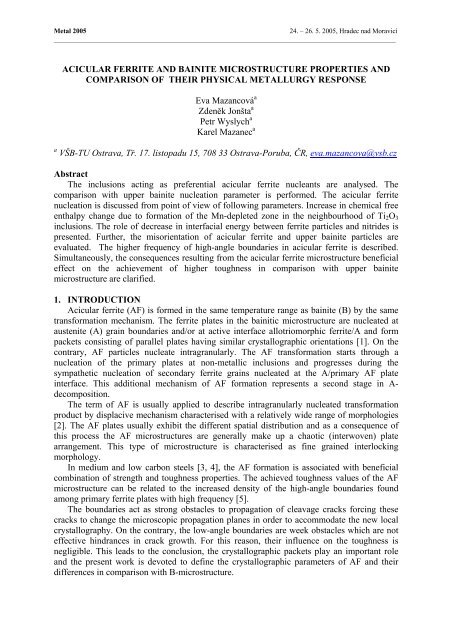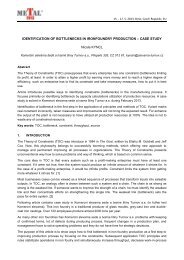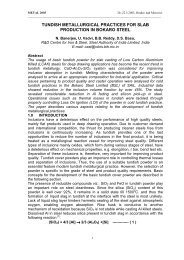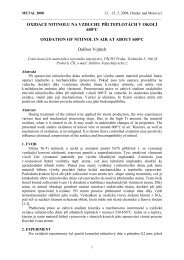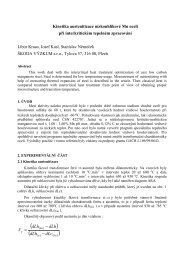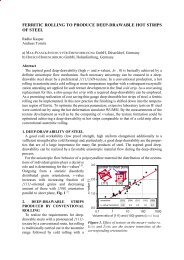ACICULAR FERRITE AND BAINITE ... - metal 2013
ACICULAR FERRITE AND BAINITE ... - metal 2013
ACICULAR FERRITE AND BAINITE ... - metal 2013
Create successful ePaper yourself
Turn your PDF publications into a flip-book with our unique Google optimized e-Paper software.
Metal 2005 24. – 26. 5. 2005, Hradec nad Moravicí<br />
____________________________________________________________________________________________________<br />
<strong>ACICULAR</strong> <strong>FERRITE</strong> <strong>AND</strong> <strong>BAINITE</strong> MICROSTRUCTURE PROPERTIES <strong>AND</strong><br />
COMPARISON OF THEIR PHYSICAL METALLURGY RESPONSE<br />
Eva Mazancová a<br />
Zdeněk Jonšta a<br />
Petr Wyslych a<br />
Karel Mazanec a<br />
a VŠB-TU Ostrava, Tř. 17. listopadu 15, 708 33 Ostrava-Poruba, ČR, eva.mazancova@vsb.cz<br />
Abstract<br />
The inclusions acting as preferential acicular ferrite nucleants are analysed. The<br />
comparison with upper bainite nucleation parameter is performed. The acicular ferrite<br />
nucleation is discussed from point of view of following parameters. Increase in chemical free<br />
enthalpy change due to formation of the Mn-depleted zone in the neighbourhood of Ti2O3<br />
inclusions. The role of decrease in interfacial energy between ferrite particles and nitrides is<br />
presented. Further, the misorientation of acicular ferrite and upper bainite particles are<br />
evaluated. The higher frequency of high-angle boundaries in acicular ferrite is described.<br />
Simultaneously, the consequences resulting from the acicular ferrite microstructure beneficial<br />
effect on the achievement of higher toughness in comparison with upper bainite<br />
microstructure are clarified.<br />
1. INTRODUCTION<br />
Acicular ferrite (AF) is formed in the same temperature range as bainite (B) by the same<br />
transformation mechanism. The ferrite plates in the bainitic microstructure are nucleated at<br />
austenite (A) grain boundaries and/or at active interface allotriomorphic ferrite/A and form<br />
packets consisting of parallel plates having similar crystallographic orientations [1]. On the<br />
contrary, AF particles nucleate intragranularly. The AF transformation starts through a<br />
nucleation of the primary plates at non-<strong>metal</strong>lic inclusions and progresses during the<br />
sympathetic nucleation of secondary ferrite grains nucleated at the A/primary AF plate<br />
interface. This additional mechanism of AF formation represents a second stage in Adecomposition.<br />
The term of AF is usually applied to describe intragranularly nucleated transformation<br />
product by displacive mechanism characterised with a relatively wide range of morphologies<br />
[2]. The AF plates usually exhibit the different spatial distribution and as a consequence of<br />
this process the AF microstructures are generally make up a chaotic (interwoven) plate<br />
arrangement. This type of microstructure is characterised as fine grained interlocking<br />
morphology.<br />
In medium and low carbon steels [3, 4], the AF formation is associated with beneficial<br />
combination of strength and toughness properties. The achieved toughness values of the AF<br />
microstructure can be related to the increased density of the high-angle boundaries found<br />
among primary ferrite plates with high frequency [5].<br />
The boundaries act as strong obstacles to propagation of cleavage cracks forcing these<br />
cracks to change the microscopic propagation planes in order to accommodate the new local<br />
crystallography. On the contrary, the low-angle boundaries are week obstacles which are not<br />
effective hindrances in crack growth. For this reason, their influence on the toughness is<br />
negligible. This leads to the conclusion, the crystallographic packets play an important role<br />
and the present work is devoted to define the crystallographic parameters of AF and their<br />
differences in comparison with B-microstructure.
Metal 2005 24. – 26. 5. 2005, Hradec nad Moravicí<br />
____________________________________________________________________________________________________<br />
2. PROMOTION OF INTRAGRANULAR AF FORMATION DUE TO<br />
NON_MRTALLIC NUCLEANTS<br />
The most of the works devoted to the AF formation has been carried out on welds. The<br />
high inclusion density which can be detected in weld materials favours AF nucleation in<br />
comparison with B-microstructure formation. Recently, the application of this microstructure<br />
to wrought steel types has been attempted by controlling the effect of selected non-<strong>metal</strong>lic<br />
inclusions acting as AF potential nucleants [6]. At the present time, a limited number of steels<br />
containing nucleating non-<strong>metal</strong>lic oxides particles is available. The attained results in Tideoxidized<br />
steels are hopeful and demonstrate the perspective using of intragranular AF<br />
nucleation process in structural steels. Under these conditions it is necessary to determine<br />
which phases of the non-<strong>metal</strong>lic inclusions, having heterogeneous character usually, are<br />
more effective as intragranular nucleants and which nucleation mechanism is realized.<br />
MnS<br />
Al 2O 3.CaO<br />
TixO<br />
MnO.TiO 2<br />
Fig.1a Extraction replica of Ti2O3 inclusion adhered with MnS and TiN.<br />
Mn - depleted zone<br />
MnS<br />
Ti2O3<br />
AF<br />
TiN<br />
Fig.1b Schematic illustration of inclusion<br />
in steel deoxidized with Ti.<br />
Although the mechanisms by which<br />
inclusions nucleate AF are not fully<br />
elucidated in detail, in following four<br />
possible variants can be taken into<br />
consideration: a) simple heterogeneous<br />
nucleation on an inert nucleant; b) epitaxial<br />
nucleation on the non-<strong>metal</strong>lic inclusion<br />
having a very good lattice registry with<br />
ferrite matrix; c) nucleation arising from the<br />
strain energy associated with the different<br />
thermal expansion coefficients of matrix and<br />
inclusion; d) nucleation accompanied with<br />
deformation of depletion zone in the matrix<br />
being in the close neighbourhood of<br />
inclusion [6]. As it results from our last<br />
investigation, the basic inclusion is also<br />
bearing particles for further active nucleants having a higher nucleation capacity for AF<br />
formation. Such basic inclusion is e.g. Ti2O3 formed in steel after secondary Ti-addition.<br />
Figure 1a shows Ti2O3 extraction replica with adhered MnS and TiN. Figure 1b presents<br />
schematic illustration of steel deoxidized with Ti-addition.<br />
By inclusion investigation in the steel with different Ti concentration, it was found, Ti2O3<br />
is more potent for AF nucleation than e.g. MnSiO3 (in steel without Ti-addition). In this case,<br />
TiN
Metal 2005 24. – 26. 5. 2005, Hradec nad Moravicí<br />
____________________________________________________________________________________________________<br />
it is useful to accept the realisation of additional nucleation mechanism to a simple<br />
heterogeneous nucleation process. Concerning Ti2O3 it has been proposed, the local depletion<br />
of A-stabilizing element (e.g. Mn by way of MnS formation adhered at TI-oxide) around<br />
inclusions promotes AF nucleation due to increase of chemical free enthalpy. The discussed<br />
depletion process is not bound with Ti2O3 (in all examples) because Mn-depletion is also<br />
detected in steel with very low sulphur content (20ppm) accompanied with very low MnS<br />
volume fraction. Further, a very important is the finding that increased Ti-addition leads to a<br />
higher AF-formation probability in comparison with intergranular B-formation. It was<br />
observed in steel without Ti-addition. For this reason it is useful to accept the proposition, the<br />
Mn-depleted zone formation may be also directly connected with Mn diffusion into Ti2O3<br />
inclusions. The source of this mechanism is a higher density of cation vacancies in Ti2O3 what<br />
leads to the enrichment of this inclusion with Mn due to increased diffusion of this element<br />
(Mn-depletion zone is found near this inclusion). It is known, Ti-oxide inclusions are<br />
characterized as particles with higher density of cation vacancies (Al2O3 inclusions are rich on<br />
anion vacancies and are not acting as intragranular nucleants) being contributing to Mn<br />
diffusion into Ti-oxide inclusion [7].<br />
3. EFFECT OF HIGH LATTICE REGISTRY OF SOME NITRIDES <strong>AND</strong> <strong>FERRITE</strong><br />
PARTICLES<br />
TiN and VN nucleation activity represent a very interesting parameter influencing the AFformation.<br />
In this case, a decrease in interfacial energy accompanied the nucleation process of<br />
alpha phase on TiN can be held for an effective parameter influencing A-decomposition. The<br />
effect of TiN should be also discussed because AF-formation is markedly suppressed in the<br />
TiN absence on Ti2O3. The TiN formation is favoured by an increase in the amount of free<br />
nitrogen in steel being available for precipitation of given nitride phase. The Ti-addition to<br />
steel by deoxidation process can be bound as Ti2O3 right after solidification [8]. The TiNformation<br />
is a result of an exchange reaction with Mn. At low and intermediate nitorogen<br />
levels in steel, the MnOSiO2 particles can be formed as it results from the following reaction<br />
[9]:<br />
Ti2O3 + Mn + N → MnOTiO2 + TiN (1)<br />
The same effect on AF nucleation can be found in the case of VN [10]. The effects of these<br />
inclusions are coincident as it results from the crystallographic similarity. The interfacial<br />
energy of the ferrite/nitride boundary is less than the interfacial energy of the A/nitride<br />
interface (γF/nit./γA/nit.< 1). Closed matching of important planes of AF and nitride lattices<br />
would promote this effect. The energy of A/nitride interface markedly depends on the<br />
formation mode of such particles. The TiN particles may compose those formed in melt prior<br />
the solidification and those precipitated from A-phase. In the case of TiN particles formed<br />
prior to solidification the interface A/TiN is incoherent (high value of γA/nit interface).<br />
However, since V-nitride is also important from point of view AF formation, factors<br />
influencing nitride precipitation in A must be considered (according Ishikawa et al. [10]), the<br />
interface properties are considered to be the same as in case of A grain boundaries.<br />
The crystal structures and lattice parameters of discussed nitrides are as follows: TiN<br />
(NaCl, cubic) a = 0.424nm and VN (NaCl cubic) a = 0.407nm. The corresponding lattice<br />
dimensions of these potential AF nucleants are presented in Fig.2. The Al nitride has h.c.p.<br />
lattice, which is very different from TiN and VN. The both considered nitrides precipitate in<br />
austenitic and ferritic matrix as plates on {100} planes. These planes are favourable since<br />
modulus E is low in direction. As these particles grow in size the interface A/nitride
Metal 2005 24. – 26. 5. 2005, Hradec nad Moravicí<br />
____________________________________________________________________________________________________<br />
will become incoherent what is beneficial situation from point of view of AF formation. The<br />
{100} planes in AF and nitride particles match as it is observed in case of thin TiN and VN<br />
having a close matching between {100} planes. The mismatch parameters are very low δ =<br />
0.0045 (TiN) and/or 0.007 (VN). The δ-value corresponds to the differences in nitride and<br />
ferritic lattice parameters divided by ferritic lattice parameter.<br />
In the case of AlN particles,<br />
close matching between the<br />
{100}, {110} and {111} planes<br />
of ferrite and important planes<br />
in the h.c.p., AlN lattice<br />
({0001}, {1010} and {1020})<br />
can not bee achieved. As a<br />
result, AlN particles in A would<br />
be unlikely sites for<br />
intragranular AF plate<br />
nucleation. In the case of ZrN<br />
particles, the conditions for<br />
matching between {100} planes<br />
of nitride and ferritic lattice are<br />
not so much favourable as it is<br />
observed by TiN and VN<br />
evaluation [11]. The TiN effect<br />
should also be considered since<br />
AF formation is partially<br />
limited in the absence of TiN<br />
nitride on Ti2O3 particles<br />
Fig.2 Ferrite plates nucleation at intragranular nitride<br />
particles in austenite.<br />
(Fig.1a). This effect results<br />
from decrease interfacial energy<br />
for AF nucleation. Increase in<br />
interfacial energy with<br />
nucleation of AF is only 0.20Jm -2 at F/A semicoherent interface and reaches to 0.85Jm -2 at<br />
A/A incoherent interface. The lattice registry between AF and TiN is very good and the<br />
interface energy is considered to be only 0.15Jm -2 aproximatelly [12].<br />
4. EVALUATION OF MISORIENTATION IN AF <strong>AND</strong> B PARTICLES<br />
The nucleation conditions and resulting relationship between intragranular and<br />
intergranular processes play a very important role by the arrangement of ferritic plates in AF<br />
In upper B (parallel ferritic sheaves vs. interwoven AF plates directly nucleated on non<strong>metal</strong>lic<br />
inclusions).<br />
The resistance to cleavage fracture in AF microstructure depends on misorientation level<br />
of its components (particles). The successful results can be obtained by the EBSD technique<br />
application which makes possible to study the local crystallographic properties of AF<br />
microstructure [5, 13]. The level of misorientation angles between neighbouring AF plates<br />
can be determined in great number of measuring. The evaluation is aimed at the finding the<br />
occurrence frequency of high angle boundaries of interfaces representing a very important<br />
hindrance from easy cleavage crack propagation in given microstructure. The deviation in<br />
crack propagation can be observed when the misorientation between neighbouring particles is<br />
higher than 15° [5, 13].
Metal 2005 24. – 26. 5. 2005, Hradec nad Moravicí<br />
____________________________________________________________________________________________________<br />
The set of determined misoreintation angles observed within AF plates is plotted in Fig.3<br />
which follows from the misorientation map of AF microstructure. The most boundaries<br />
correspond to high angle boundaries between AF plates, while small misorientation<br />
boundaries (< 15°) can be found within high angle boundaries. The majority of measured high<br />
angle boundaries correspond to the misoreintation angle higher than 45° [13]. Concerning B<br />
microstructure (upper B) the set of misorientation angles is different from AF microstructure.<br />
The occurrence of misorientation peaks is scarce in B microstructure. The distance between<br />
the high-angle boundaries is in AF microstructure 3-5µm approximately. The evaluated<br />
distance is in the B microstructure 15µm approximately. The high angle misorientations can<br />
be detected at grain boundaries of B-packets. In AF microstructure, the density of highly<br />
crystallographic misoriented plates is<br />
enhanced by a profuse direct nucleation<br />
misorientation angle<br />
[degree]<br />
80<br />
60<br />
40<br />
20<br />
0<br />
Point to point<br />
0 5 10<br />
Distance to point A [µm]<br />
Fig.3 Misorientation angle between AF plates.<br />
on inclusion particles. In this case it<br />
does not seem possible to relate the<br />
morphological packet to the<br />
microstructural unit which controls the<br />
cleavage crack propagation in B<br />
microstructure. The microstructure unit<br />
can be directly related to the set of AF<br />
plates enclosed by high-angle<br />
boundaries.<br />
In the case of B, a morphological<br />
packet size (dB) has been previously<br />
defined and related to the unit crack<br />
path (UCP) [13, 14]. This distance is<br />
defined as the region in which the crack<br />
propagates in a straight line and really<br />
corresponds to the free path between<br />
two neighbouring high-angle<br />
boundaries. This demonstrates, the<br />
misorientation higher than about 10-15° between {100} cleavage planes corresponding to two<br />
adjacent B-packets are able to markedly deflect the brittle crack propagation [15].<br />
Fig.4 Histogram of misorientation angle distribution found in AF and B microstructure
Metal 2005 24. – 26. 5. 2005, Hradec nad Moravicí<br />
____________________________________________________________________________________________________<br />
adjacent B-packets are able to markedly deflect the brittle crack propagation [15]. Figure 4<br />
shows the distributions of plate misorientation level determined in AF and B microstructure<br />
(evaluated frequency is plotted in dependence on misorientation angle) in histogram form.<br />
A very interesting crystallographic finding resulting from these dependences is the absence of<br />
misorientation across plate boundaries within the range of 20-47° approximately [1, 5]. These<br />
results are consequence of A-decomposition by the displacive mechanism. The formed AF<br />
plates exhibit misorientation angles lying between 47-60° as it corresponds to near N/W<br />
relationships with the parent (austenitic) phase. The same relationships were found in upper B<br />
microstructure. In the case of the AF, the microstructure is found to be very close to the self<br />
accommodating microstructure arrangement of martensite which is favourable for the<br />
realisation of shears stress accommodation process [5, 13].<br />
The ductile - brittle transition temperature Tx is usually expressed as being inversely<br />
proportional to the root square of distance between high-angle grain boundaries. The crack<br />
propagation can be arrested at high-angle boundaries. The parameters of this process depend<br />
on the microstructural characteristics of given steel type. In AF microstructure, the density of<br />
crystallographic misorientation planes is enhanced in comparison with upper B (Fig.4). The<br />
observed AF microstructure is beneficial due to higher probability in realisation of<br />
ascertainable brittle crack deflection than can be detected in upper B microstructure [5, 13,<br />
15].<br />
The following type of equation has been used to describe the ductile-brittle transition<br />
temperature in steel [13]:<br />
Tx = T0 – K.d -1/2 (2)<br />
Where K is a constant, T0 only depends on the tensile properties of the material and d<br />
represents the mean linear intercept between high-angle boundaries. The value of d in steel<br />
having AF microstructure is smaller than the distance d between boundaries of B packets.<br />
This comparison confirms a beneficial influence of interlocked AF microstructure [5].<br />
5. CONCLUSIONS<br />
The study has been carried out to clear up the basic physical <strong>metal</strong>lurgy principles<br />
controlling the AF and B formation. The effect of some inclusions, known as AF potential<br />
nucleants, is analysed. The attention has been devoted to the study of nucleating behaviour of<br />
Ti-oxides (Ti2O3) and the additional influence of MnS and TiN particles. Such particles form<br />
together the heterogeneous type of nucleants (formation of Mn-depleted zone in the<br />
neighbourhood of Ti2O3 oxides and the influence of low interfacial energy between TiN<br />
and/or VN and ferritic matrix – AF).<br />
The AF particles are intragranularly nucleated, while the intergranular nucleation<br />
corresponds to B formation. The AF microstructure is characterised with increased frequency<br />
of a high-angle boundary. On the contrary, B microstructure is characterised with higher<br />
occurrence of low-angle boundaries what leads to lower resistance to cleavage crack<br />
propagation and to larger unit crack path (UCP). The mechanical <strong>metal</strong>lurgy consequences of<br />
these parameters (AF vs. B) are elucidated.<br />
Acknowledgements<br />
The authors acknowledge the Grant agency of Czech Republic for financial support of<br />
project No. 106/03/0264.
Metal 2005 24. – 26. 5. 2005, Hradec nad Moravicí<br />
____________________________________________________________________________________________________<br />
REFERENCES<br />
[1] BADESHIA, H.K.D.H. Bainite in steels, 2 nd edit., London, The Inst. of Materials,<br />
Cambridge, 2001, 451p.<br />
[2] MADARIAGA, I. et al. Met. Mater. Trans., 32A, 2001, pp. 2187-2197.<br />
[3] LINAZA, M.A. et al. Scr. Mater., 32, 1995, pp. 395-400.<br />
[4] DIAZ-FUENTES, M. et al. Mater. Sci. Forum, 284-286, 1998, pp. 245-252.<br />
[5] GOURGUES, A.F. et al. Mater. Sci., Technol., 16, 2000, pp. 26-40.<br />
[6] BYUN, J.S. et al. Acta Mater., 51, (2003), pp. 1593-1606<br />
[7] TAKAMURA, S. et al. Roles of oxides in steels performance-<strong>metal</strong>lurgy of oxides in<br />
steels. In Proceedings of the 6 th International Iron and Steel Congress. ISIJ Nagoya,<br />
1990, pp. 551-597.<br />
[8] JUNG, I.H. et al. ISIJ International, 44, (2004), pp. 527-536.<br />
[9] VAN DER Eijk,C. et al. Material Sci. Technol., 16, 2000, pp. 55-64.<br />
[10] ISHIKAWA, F., TOKAHASHI, T. ISIJ International, 35, (1995), pp. 1128-1134.<br />
[11] NORTH, T.H. et al. Welding Journal, Welding Research Supplement, 57, (1979), pp.<br />
343s-354s.<br />
[12] YAMAMOTO,K. et al. ISIJ Inter., 36,1996, pp. 80-86.<br />
[13] DIAZ-FUENTES, M. et al. Met. Mater. Trans., 34A, 2003, pp. 2505-2516.<br />
[14] BROZZO, P. Met. Science, 11, 1977, pp. 123-129.<br />
[15] MAZANCOVÁ, E. et al. Zeszyty Naukowe Politechniky Opolskej, Mechanika, 78,<br />
2004, pp. 113-118.


